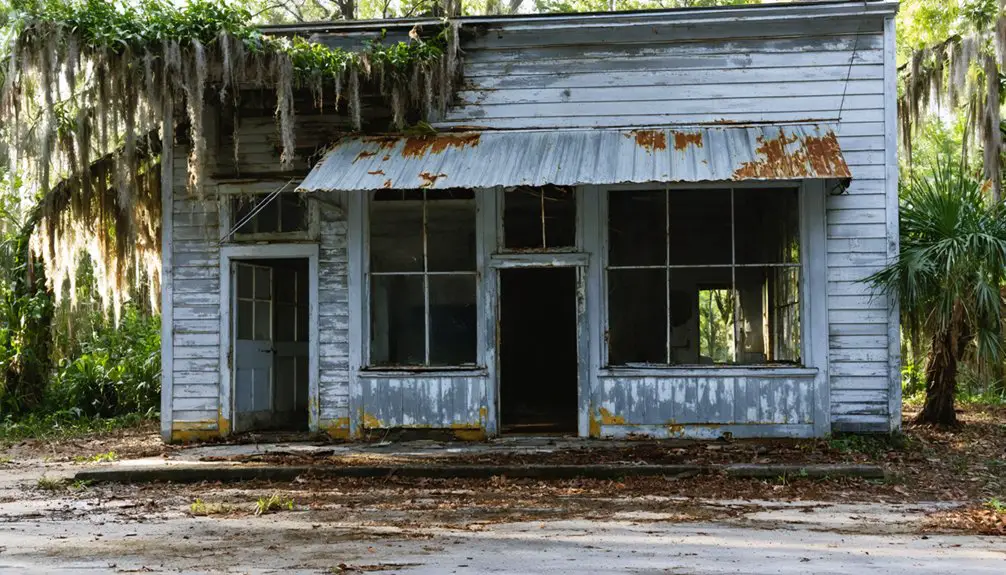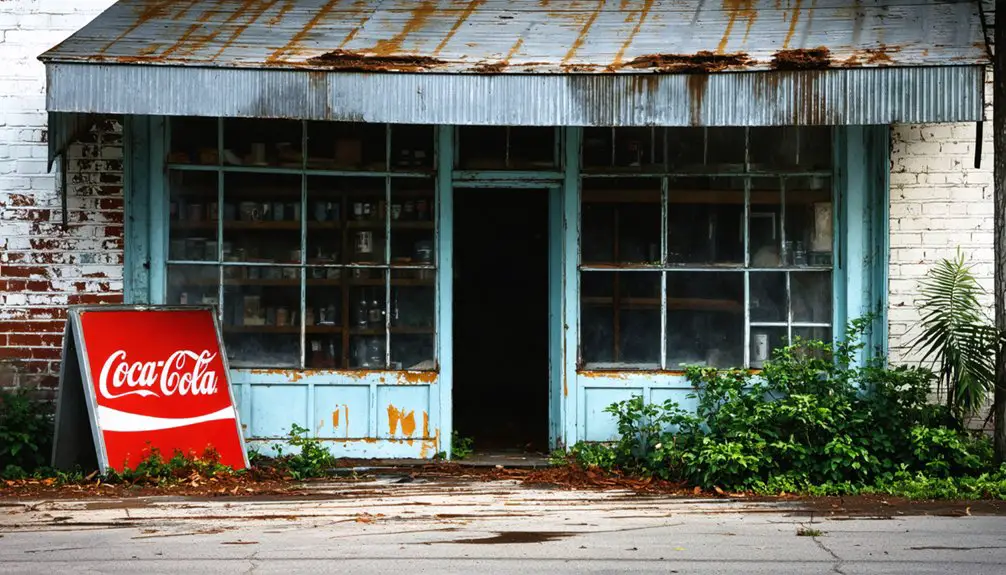You’ll find Allenhurst’s ghost town remnants along Haulover Canal on Merritt Island, Florida, where a vibrant fishing community once thrived. By 1939, about 50 residents called this waterfront settlement home, establishing deep-rooted fishing traditions and prime angling spots. The town flourished as a sport fishing destination until 1963, when NASA’s Kennedy Space Center expansion absorbed the area. Today, only a small gravesite on NASA property hints at the rich maritime heritage waiting to be uncovered.
Key Takeaways
- Allenhurst was a small fishing community on Merritt Island, Florida that became a ghost town after NASA’s Kennedy Space Center expansion in 1963.
- The town peaked at around 50 residents by 1939, with its economy centered around fishing activities along Haulover Canal.
- Only a small gravesite remains on NASA-controlled property, with no standing structures or historical markers visible today.
- The community’s decline began with railroad expansion in 1892, which isolated the town due to lack of rail connections.
- The town’s history is preserved through local historical societies, with records accessible through National Park Service archives and academic publications.
The Rise of a Fishing Community
Nestled along Haulover Canal on Merritt Island in Brevard County, Florida, Allenhurst emerged as a small but vibrant fishing community in the early 20th century.
You’d find about 50 residents there by 1939, mostly fisherfolk who’d built their lives around the abundant waters.
The area’s reputation for prime fishing spots drew both sports enthusiasts and commercial operators, establishing deep-rooted fishing traditions that shaped the community’s identity.
Local fish camps served as essential hubs where you’d witness strong community bonding among residents and visitors alike.
Despite its remote location and basic infrastructure, Allenhurst thrived through its connection to the water, with steamboats regularly passing through Haulover Canal, transporting cargo and passengers until the railroad’s arrival in 1892.
The historic Florida Coast Line Canal modernized the waterway in 1887, improving transportation access for the growing community.
Local residents like J. Sykes cultivated sweet potatoes alongside their fishing activities, demonstrating the community’s self-sustaining nature.
Life Along Haulover Canal
The daily rhythms of life in Allenhurst revolved around Haulover Canal‘s bustling waterway, which began as a humble hand-dug channel in the 1850s.
You’d find locals making their living through boat hauling, fishing, and providing services to travelers steering between Mosquito Lagoon and Indian River.
The canal ecology shaped community dynamics, as residents adapted to the ebb and flow of maritime commerce. Local slaves worked tirelessly to carve through the dense Coquina rock formations.
You could spot cargo vessels and passenger steamboats making regular runs from Daytona to Miami, while fishermen cast their nets in the nutrient-rich waters.
When the canal expanded to 125 feet wide and 12 feet deep in 1927, it transformed local operations.
Yet the community’s liveliness began to fade as Flagler’s railroad reached Titusville in 1892, slowly shifting transportation patterns away from the waterways.
The area’s maritime history dates back to 1605, when Spanish explorers first traversed these waters using local resources.
Transportation’s Role in Growth and Decline
While steamboats once dominated transportation through Haulover Canal, connecting Allenhurst to bustling ports from Daytona to Miami, this maritime prosperity proved short-lived.
Before the railroad era, a local ferry master operated the only river crossing service in the region.
Flagler’s railroad expansion in 1892 triggered a dramatic transportation evolution, delivering a fatal blow to the region’s steamboat commerce. The area’s economic vitality had previously depended on vital rail connections between communities.
The railroad’s arrival in 1892 marked the death knell for steamboat traffic, forever altering the region’s transportation landscape.
You’ll find that Allenhurst’s isolation intensified as it lacked both rail connections and proper roads.
Even when residents pushed for the Allenhurst-Shiloh Road and a $25,000 drawbridge project in 1921, the bridge wasn’t completed until 1933.
These infrastructure gaps had profound economic implications, keeping the population around 50 residents by 1939.
The final transformation came in 1963 when NASA’s Kennedy Space Center expansion absorbed the town, shifting regional transportation priorities and cementing Allenhurst’s fate as a ghost town.
The Golden Age of Sport Fishing
During Florida’s early sport fishing boom, Allenhurst emerged as a premier angling destination thanks to its strategic position near Haulover Canal, where both Indian River and Mosquito Lagoon waters converged.
You’d find anglers pursuing diverse species, from the mighty tarpon that first put Florida on the sportfishing map to the high-jumping sailfish that gained popularity in the 1910s.
As fishing techniques evolved, so did the equipment – newer reels featured innovative leather thumb brakes and star drags, giving you better control when battling large saltwater fish. Many enthusiasts opted for the durability of split bamboo rods that dominated the market before fiberglass became widespread.
The region’s species diversity, including barracuda and king mackerel, drew countless sportsmen to Allenhurst’s productive waters. Today, the area remains a slow speed zone to protect marine life while still maintaining its reputation as a prime fishing location.
This golden age of fishing lasted until NASA’s expansion forced the town’s residents to relocate, ending an era of remarkable angling history.
Daily Life in a Waterfront Town
Life along Haulover Canal shaped every aspect of Allenhurst’s community, from its modest waterfront homes to its daily routines centered on fishing and boating.
You’d find residents mending nets, maintaining boats, and processing their catches as part of their everyday work. The canal’s tidal rhythms and seasonal patterns dictated the flow of activity, while the mix of fresh and salt water created prime fishing grounds right at your doorstep. For accurate historical documentation, the town was added to place name listings to distinguish it from other Allenhurst locations.
The waterfront fostered tight-knit bonds through community gatherings and shared fishing traditions. You’d join neighbors at boat ramps and manatee viewing platforms, swapping stories of the day’s catch. The town’s identity as a sports fishing community defined its character until its final days.
While the town lacked formal institutions, the freedom of waterfront living compensated through rich social connections and a lifestyle deeply attuned to nature’s cycles.
NASA’s Arrival and Community Displacement
As NASA began acquiring vast tracts of Merritt Island in 1962, Allenhurst’s fate was sealed alongside other small coastal communities. The massive land acquisition program transformed over 80,000 acres of coastal Florida into what would become Kennedy Space Center, forever altering the region’s landscape and community identity.
The impact on Allenhurst residents was swift and absolute:
- Federal purchases and eminent domain forced families from their homes.
- Traditional fishing and farming livelihoods were immediately disrupted.
- Entire neighborhoods were demolished to create safety buffer zones.
You wouldn’t recognize the area today – where fishing boats once dotted the shoreline, NASA’s industrial complexes now dominate. The Vehicle Assembly Building stands as a towering symbol of progress, but beneath its shadow lies the erased history of Allenhurst’s tight-knit waterfront community.
Geographic Features and Natural Setting

Three distinct waterways – the Haulover Canal, Indian River, and Mosquito Lagoon – defined Allenhurst’s strategic location on Florida’s Space Coast.
Situated where three vital waterways converge, Allenhurst embodied the nautical gateway to Florida’s emerging Space Coast region.
You’ll find this former settlement between 28.73° N latitude and 80.75° W longitude on Merritt Island, where coastal ecosystems thrive in the humid subtropical climate.
The area’s flat, low-lying terrain features sandy beaches stretching northward to Playalinda, while mangroves and marshes dot the landscape.
Waterway access remains possible via dirt roads from Courtenay Parkway, leading to boat ramps where you can explore the surrounding lagoons.
Today, the land falls under NASA’s management, with special platforms for observing manatees and other wildlife.
The unspoiled environment showcases Florida’s natural beauty, from tidal inlets to the preserved coastline within Merritt Island National Wildlife Refuge.
Preserving Allenhurst’s Memory
Today you’ll find Allenhurst’s history preserved mainly through fragments of documentation scattered across local historical societies and ghost town registries, rather than through physical remnants.
While detailed records about the community remain scarce, former residents’ stories provide invaluable insights into daily life before NASA’s Kennedy Space Center construction displaced the town.
Digital platforms and academic research now help keep Allenhurst’s memory alive by collecting these narratives alongside historical maps and photographs that document the community’s existence.
Historical Documentation Efforts
Several organizations have worked diligently to preserve Allenhurst’s memory through extensive documentation efforts.
Through community collaboration, the North Brevard Heritage Foundation and Historical Society have partnered with regional historians to maintain essential records of this lost town. The archival significance of these preservation efforts can’t be overstated.
Key documentation includes:
- Historic photographs, including the notable 1901 image of Mr. J Allen at the post office, preserved by local historian Roz Foster
- National Park Service’s 2008 Historic Resource Study incorporating Allenhurst’s role in the region
- Cross-referenced oral histories and photographic collections from contributors like John “Kip” Hulvershorn
You’ll find these records accessible through National Park Service archives, local heritage organizations, and academic publications focusing on Florida’s ghost towns.
Stories From Former Residents
Former residents of Allenhurst have left behind rich accounts of life in this once-vibrant fishing community, painting a portrait of daily routines along the Indian River and Haulover Canal before NASA’s arrival.
Through personal anecdotes collected by J. Francis LeBaron, you’ll discover stories of a defiant yet simple way of life centered around the water.
The testimonials reveal strong community bonds formed through shared maritime traditions and a relaxed lifestyle that defined this small settlement.
You’ll find tales of adaptation as the town shifted from steamboat to railroad transport, fundamentally changing how locals conducted trade.
Despite their physical town being erased in 1962-1963, former residents‘ memories preserve Allenhurst’s spirit as a close-knit fishing haven where nature and tradition intersected before progress forced change.
What Remains Today: A Historical Site

The remnants of Allenhurst, Florida exist solely as a small gravesite on NASA-controlled property north of Haulover Canal in Brevard County.
Unlike other Florida ghost towns that maintain visible structures or historical markers, Allenhurst’s physical presence has been almost completely erased by NASA’s mid-20th century expansion.
Today, you’ll find three key aspects of this historical site:
Modern visitors to Allenhurst will discover only three remaining elements that hint at the town’s former existence.
- A preserved gravesite area marking the former community’s burial ground
- Access via a route connecting to Route 3 Kennedy Parkway on NASA property
- Natural landscape that’s reclaimed where homes and businesses once stood
The cultural impact of Allenhurst’s transformation from a thriving sport fishing community to restricted federal land serves as a stark reminder of how national priorities can reshape local communities, leaving only minimal traces of their existence.
Frequently Asked Questions
What Was the Average Home Price in Allenhurst During the 1950S?
You’d find 1950s housing in the $6,500 to $7,000 range, likely below Florida’s median real estate trends. Given the town’s smaller status, prices probably trended lower than the state’s $6,612 average.
Were There Any Schools or Churches Established in Allenhurst?
You won’t find any historic buildings for schools or churches in the records. The small fishing community, which peaked at 50 residents, didn’t support formal community gatherings beyond fishing activities.
Did Any Famous People Ever Visit or Live in Allenhurst?
You won’t find records of any famous visitors or celebrity sightings in this small fishing village. Historical documents show it remained a modest community of fisherfolk until NASA’s expansion forced residents out.
What Types of Jobs Existed in Allenhurst Besides Fishing?
You’d find work in agricultural fields tending citrus groves and watermelon patches, cut lumber in pine forests, harvest turpentine from trees, or serve tourists in small local businesses.
How Much Did NASA Pay Residents for Their Properties?
You’d have received varied property compensation based on individual relocation agreements, with larger parcels valued between $200,000-$1.5 million, though most landowners felt NASA’s appraisals considerably undervalued their properties.
References
- https://www.nbbd.com/godo/history/dyk/b-lebaron-haulover.html
- https://en.wikipedia.org/wiki/Allenhurst
- https://www.ghosttowns.com/states/fl/allenhurst.html
- https://en.wikipedia.org/wiki/List_of_ghost_towns_in_Florida
- http://www.gribblenation.org/2018/02/ghost-town-tuesday-ghost-towns-of.html
- https://indianriverlagoonnews.org/guide/index.php/Haulover_Canal
- http://www.shrimpnfishflorida.com/forums/threads/remembering-fish-camps-and-marinas.10006/
- https://www.nbbd.com/godo/history/dyk/b-lost-towns.html
- https://www.nbbd.com/godo/history/Haulover-Canal/index.html
- https://en.wikipedia.org/wiki/Haulover_Canal



